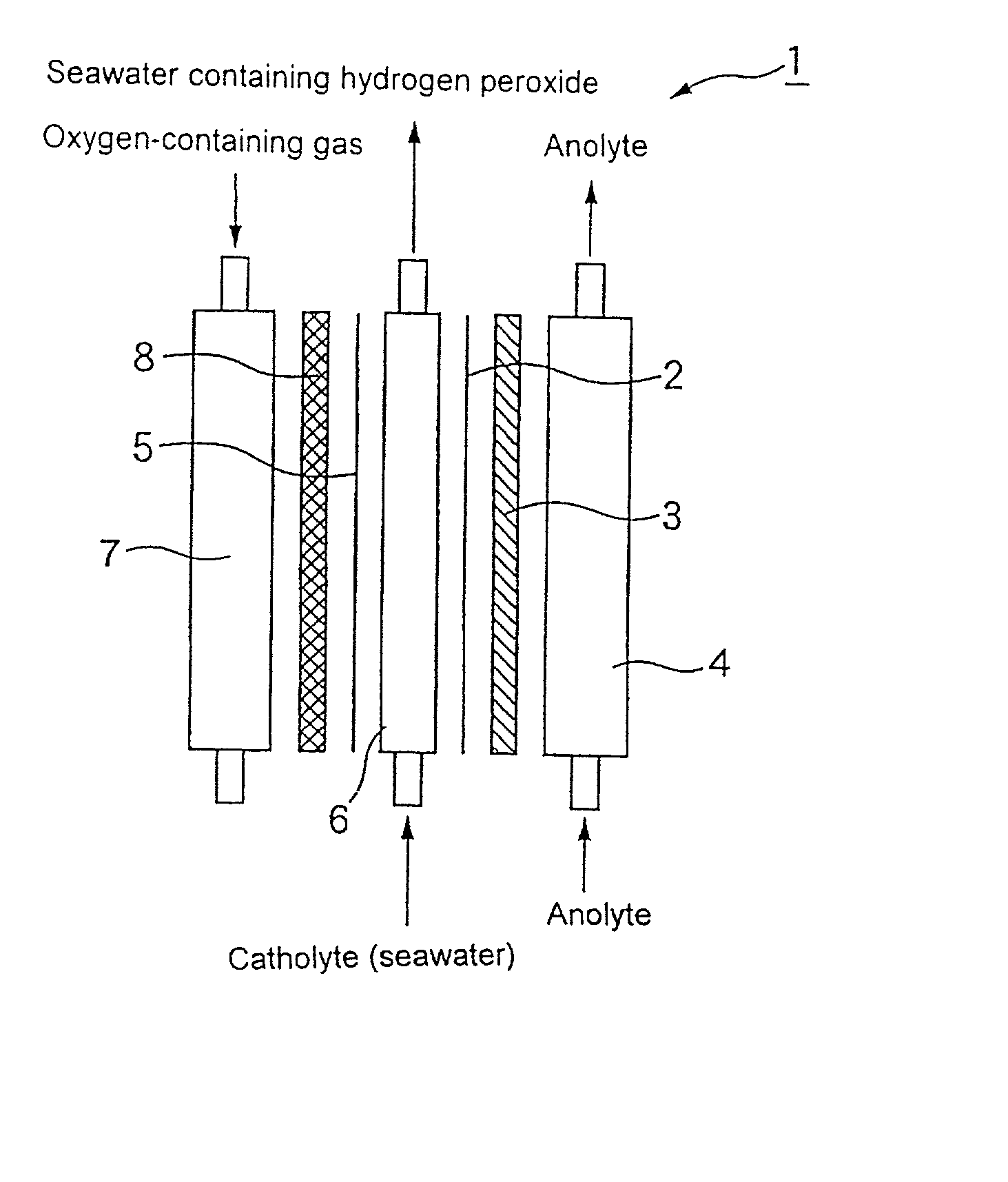Process for the production of hydrogen peroxide solution
a hydrogen peroxide and hydrogen peroxide technology, applied in the direction of peroxide/peroxyhydrate/peroxyacid/superoxide/ozonide, chemistry apparatus and processes, etc., can solve the problems of large environmental damage, hydrogen peroxide is too unstable to store, and the effect of avoiding the production of effective chlorine or thm
- Summary
- Abstract
- Description
- Claims
- Application Information
AI Technical Summary
Benefits of technology
Problems solved by technology
Method used
Image
Examples
example 1
[0050] An iridium oxide catalyst was supported on a porous titanium sheet in an amount of 10 g / m.sup.2 by a thermal decomposition method to prepare an anode.
[0051] A carbon powder (Type XC-72 furnace black, produced by Vulcan Inc. of U.S.A.) as a catalyst was kneaded with a PTFE resin. The mixture was applied to a carbon cloth (produced by Nippon Carbon Co., Ltd.), and then calcined at a temperature of 330.degree. C. to prepare a sheet having a thickness of 0.4 mm as an oxygen gas electrode.
[0052] The foregoing anode was placed in close contact with an ion exchange membrane (Nafion 117, produced by Du Pont Inc.). The foregoing oxygen gas electrode was arranged such that the distance between the oxygen gas electrode and the anode electrode was 5 mm. As a result, an electrolytic cell shown in FIG. 1 having an effective electrolysis area of 150 cm.sup.2 and comprising an anode chamber and a cathode chamber (solution chamber and gas chamber) was assembled.
[0053] An electric current of 1...
example 2
[0056] An electrolytic cell was assembled in the same manner as in Example 1, except that an anode obtained by subjecting a porous titanium sheet to electrodeposition in an acidic aqueous solution of manganese sulfate to support a manganese dioxide catalyst thereon in an amount of 50 g / m.sup.2 was used. Electrolysis was effected using this electrolytic cell.
[0057] Seawater having a hydrogen peroxide content of 1,000 ppm was obtained at the outlet of the solution chamber at a current efficiency of about 95%. The effective chlorine concentration of tap water at the outlet of the anode chamber was not greater than 1 ppm. At this point, the concentration of THM at the outlet of the solution chamber fell below the limit of detection.
example 3
[0058] An electrolytic cell was assembled in the same manner as in Example 1, except that as the anolyte supplied to the anode chamber was industrial water having a chloride ion concentration of 20 ppm and TOC of 2 ppm. Electrolysis was effected using this electrolytic cell.
[0059] Seawater having a hydrogen peroxide content of 1,000 ppm was obtained at the outlet of the solution chamber at a current efficiency of about 95%. The effective chlorine concentration of tap water at the outlet of the anode chamber was not greater than 50 ppm. The cell voltage was 7.5 V. At this point, the concentration of THM at the outlet of the solution chamber fell below the limit of detection.
PUM
| Property | Measurement | Unit |
|---|---|---|
| concentration | aaaaa | aaaaa |
| concentration | aaaaa | aaaaa |
| concentration | aaaaa | aaaaa |
Abstract
Description
Claims
Application Information
 Login to View More
Login to View More - R&D
- Intellectual Property
- Life Sciences
- Materials
- Tech Scout
- Unparalleled Data Quality
- Higher Quality Content
- 60% Fewer Hallucinations
Browse by: Latest US Patents, China's latest patents, Technical Efficacy Thesaurus, Application Domain, Technology Topic, Popular Technical Reports.
© 2025 PatSnap. All rights reserved.Legal|Privacy policy|Modern Slavery Act Transparency Statement|Sitemap|About US| Contact US: help@patsnap.com


